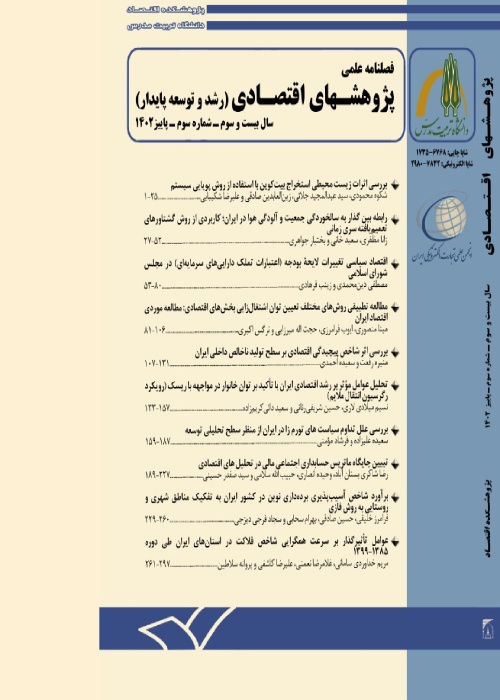Capacity Measurement of Capital Formation in Isfahan Province Based on Interregional Dynamic Input-Output Model
The lack of statistical data at the regional level has led to the expansion of non-statistical methods for the regionalization of national input-output tables. The main idea of the current research is the regionalization of national dynamic input-output tables using the extension of the Charm method. This research using this non-statistical method provides an estimate of the sectoral capital matrix in the regional level, and finally, with the help of the numerical index of capital productivity and the Williamson’ capital index and comparing it with the relative advantage index, it measures the capacity of capital formation. Part of it is in Isfahan province. The results show that the industry sector with the largest share of output from the total output of the province has the lowest numerical index of capital productivity and the highest balanced diffusion effects of capital and the highest comparative advantage in 2015.
One of the most efficient methods for examining intra-regional economic capacities is the use of intra-regional and inter-regional capital matrix. In Iran, due to the lack of sufficient statistical data, no attempt has been made to estimate the sectoral capital matrix in the regional level. The purpose of the current research is to regionalize the national dynamic input-output table with the help of expanding the CHARM non-statistical method and estimating the intra-regional and inter-regional capital matrix; to provide an analysis of the capital capacity of different economic sectors in the region with the help of these matrices. In the current research, among all the non-statistical regionalization methods of the national input-output tables, the Charm approach has been selected in accordance with the regional data. The reason for choosing Charm method is the existence of Cross Hauling in Isfahan province. One of the problems of Charm's method is the placement of national and regional technology coefficients. This simplifying assumption causes the intermediate demand within the region to increase and therefore the added value, which is estimated as a residual; it will be very small or even negative. For this purpose, the current research will regionalize the matrix of national technology coefficients with the help of spatial coefficients; to solve the problem. By estimating the regional capital matrix, an analysis of the final productivity of the sector's capital factor and inter-sector capital distribution will be presented, and the results of these sectors will be compared with the indicators of comparative advantage of the sector. Finally, the research questions will be answered:
Which effect will the adjustment of the national technology coefficients have on the added value of the province?
What is the capital matrix of the sector in Isfahan province?
Which sector in Isfahan province has the highest numerical index of capital productivity?
Which economic sectors in Isfahan province have more distribution of capital formation?
What are the economic sectors with the greatest comparative advantage in Isfahan province?
At first, it is necessary to estimate the national capital matrix with the help of available data and simplifying assumptions. By estimating the national dynamic input-output table, we will have an estimate of the regional dynamic input-output table with the help of the extension of Charm method. To solve the problem of equality of national and regional technology coefficients, by multiplying the diagonal matrix of spatial coefficients in the matrix of national technology coefficients, we will obtain the spatial technology matrix of the region, and by multiplying this estimated matrix in the resulting diagonal matrix, we will obtain the regional technology matrix. Therefore, smaller regional coefficients will be estimated.
On the other hand, to estimate the intra-regional capital matrix, the difference ratio of the region's output in two periods is used to the same amount at the national level. In this case, the intra-regional capital matrix is estimated. A time interval of one year is considered. The reason for choosing this time interval is that the country's budget is one year and a huge part of the inter-sectoral investment in the region is done by the central government. To estimate the intra-regional capital matrix, the spatial ratio of the region's capital asset ownership to the entire country is used. Finally, by subtracting the national capital matrix from the intra-regional capital matrix, we will get an estimate of the correct inter-regional capital matrix. Finally, with the estimation of the capital matrix, the assessment of the capital formation capacity of the intra-regional sector of Isfahan province is carried out with the help of single-factor productivity analysis of capital and the Williamson index of capital and the estimation of the relative advantage index.
In the case that the coefficients of national technology are equal to regional technology, the added value is negatively estimated in four sectors, agriculture, mining, water and electricity, gas and construction. This is despite the fact that in the proposed method of the current research, these positive values are estimated. According to the capital matrix, the most productions were related to the industry, construction and agriculture sectors. Also, the most capital purchases were related to industry, services and real estate sectors. The highest level of sector productivity is related to the communication, mining and transportation sectors. One of the reasons for the increase in user productivity((L↑)/K ) of the sector is compared to other economic sectors. According to Wilsamson's index, the industrial sector, as a supply sector, has distributed its produced capital goods in a more balanced way among the demand sectors. Three sectors, industry, transportation and real estate, have the greatest comparative advantage according to both indicators. But none of the sectors has a high relative advantage.
In summary, the results show that the industry sector with the largest share of output from the total output of the province had low productivity in 2015. Meanwhile, according to Williamson's index, this sector has the most balanced emission effects with other economic sectors, and the results of the previous link also confirm this. Also, based on the RCA and SRCA indices, this sector has a comparative advantage. Therefore, paying attention to new investment in this sector and improving production technology can have good effects on the sector itself and ultimately on other economic sectors in the region.
- حق عضویت دریافتی صرف حمایت از نشریات عضو و نگهداری، تکمیل و توسعه مگیران میشود.
- پرداخت حق اشتراک و دانلود مقالات اجازه بازنشر آن در سایر رسانههای چاپی و دیجیتال را به کاربر نمیدهد.



